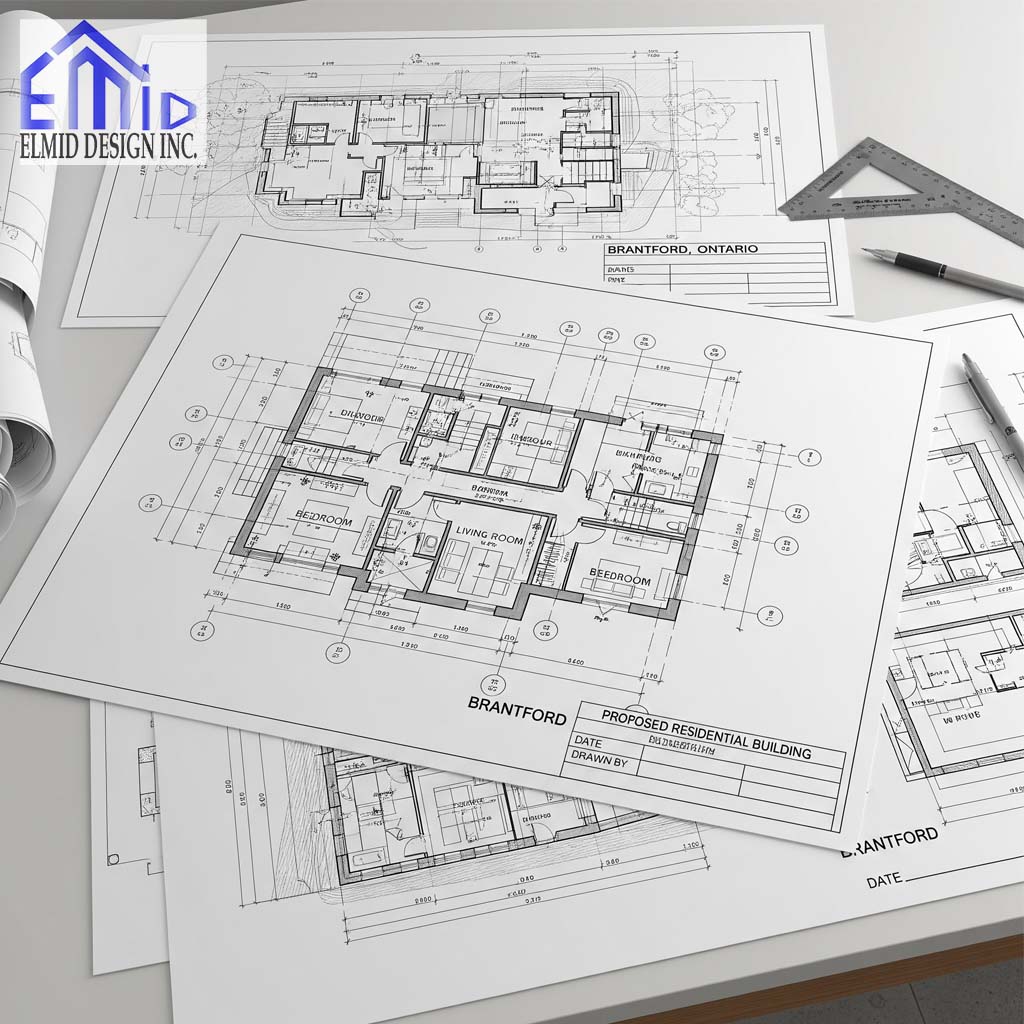Expect clarity and guidance in this overview of permit drawings in Brantford, Ontario. This article directly addresses what permit drawings mean for homeowners and builders in Brantford. If you’re planning construction and want municipal approval, this guide helps you understand essential rules, processes, and timelines. Furthermore, it equips you for smooth navigation of local permit requirements and highlights how professional oversight—such as that provided by a PEO-authorized firm—can enhance both credibility and compliance.
What Permit Drawings Involve
Permit drawings serve as detailed blueprints for architectural, structural, electrical, and mechanical work. In Brantford, these drawings must satisfy the Ontario Building Code and local bylaws. Specifically, they help the City’s Chief Building Official and inspectors assess whether your project meets safety, zoning, and legal standards. Additionally, the drawings often include site surveys, floor plans, elevations, and technical detail. Therefore, they must be clear, accurate, and engineered when required.
Legal Framework and Required Documents
Permit applications in Brantford must include a fully completed form, application fees, and precise plans and specifications. The package must encompass a description of the work, land location details, and documentation demonstrating compliance with building regulations. If the Ontario Building Code requires general review by a professional, both an owner’s acknowledgment and the professional’s signature must be included. Professionals must be architects or professional engineers in good standing. These are City requirements under the Building Code Act, the Building Code and local by‑laws.
Different Permit Types and Drawing Requirements
Permit requirements in Brantford vary by project type. For demolition, demolition-specific forms and utility disconnection proof are mandatory. Residential decks require site plans, elevation drawings and framing details. Additions or renovations require foundation and framing plans plus elevation and section drawings. Site grading or septic systems need soil reports and drainage details. The City sets these standards to ensure each proposal is properly evaluated.
Submission Process via Cloudpermit
Brantford uses the Cloud permit system to streamline permit applications. You may submit drawings online, track status, receive automated emails for missing information and schedule inspections. You may pay digitally once invoiced. This modern platform speeds up review and enhances communication. City staff no longer rely on manual follow-up, which serves applicants well.
Timing and Common Delays
Permit review often takes two to four weeks, depending on project size and complexity. Simple residential renovations may complete in 10 business days, while larger builds might take 15 days or more. Delays often stem from incomplete applications, missing drawings, or structural omissions in the plans. Ensuring your permit drawings are comprehensive reduces wait times significantly.
Fees and Additional Charges
Permits carry a minimum fee—around $250 for smaller Part 9 buildings and up to $1 000 for Part 3 structures. If construction begins before permit approval, additional administrative charges may apply, ranging from 25 to 100 percent of the full fee based on work completion stages like foundation or framing.
Role of Zoning and Site Plan Control
Your property must adhere to Brantford’s Zoning By‑law 124‑2024, which regulates land use, building height and setbacks. Permit drawings must reflect zoning compliance. Some projects also require Site Plan Control approval, which demands detailed site layouts addressing building footprint, drainage, driveways and municipal services. Pre‑consultation with Planning staff can clarify project requirements.
Why Professional Support Matters
Engaging a qualified BCIN designer, architect or PEO‑authorized firm adds credibility to your submission. Their expertise ensures code compliance and reduces errors. Professionals deliver engineered drawings where required and can sign required statements. Working with trusted firms helps satisfy City expectations and reinforces expertise, authority and trust.

Importance of Accurate Site Plans in Brantford
Site plans provide the foundation for every building permit application. In Brantford, an inaccurate or vague site plan may lead to rejection or long delays. This drawing must show lot boundaries, existing structures, proposed changes, and distances to property lines. Drainage, easements, and right-of-way access must also be included. The City relies heavily on this document to assess zoning compliance and environmental impact. Submitting a properly scaled site plan is a critical first step in the permit process and requires precision. Errors often result from overlooking minor details, which planning officers quickly identify.
Permit Drawings for Heritage Properties
Brantford has a number of heritage-designated properties, each governed by its Heritage Permit Application process. For any alteration, even if structural work is not involved, applicants must provide detailed drawings. These must reflect the preservation of historic features while incorporating modern improvements. Drawings must clearly indicate which parts of the structure will remain unchanged and which will be affected. Failing to comply may halt a project or trigger legal consequences. Municipal Heritage Committee review may also apply depending on the scope and nature of the proposed work. Getting approval can take extra time.
Basement Renovations and Permit Drawings
Basement renovation projects almost always require detailed permit drawings. Brantford’s building department checks these to ensure compliance with fire separation, egress window dimensions, insulation values, and HVAC upgrades. Drawings must include existing conditions and proposed layout changes. If adding a secondary suite, extra requirements apply such as a separate entrance, fire-rated partitions, and additional mechanical work. Inadequate drawings will stall your application and inspections will be delayed. Only a clear and detailed set will ensure municipal compliance and faster project timelines. Homeowners often underestimate the importance of accuracy at this stage.
Load-Bearing Wall Removals in Drawings
If you plan to remove a load-bearing wall in Brantford, your permit drawings must clearly show the structural changes. In this case, the City requires a professional engineer to review these drawings. Your plans must show exactly how the structure will carry the new load, usually with engineered beams or posts. In addition, include connection points and foundation details to prove the load transfers safely. Missing or vague details often lead to permit rejection and expensive redesigns. A licensed engineer must stamp the drawings to confirm they meet the Ontario Building Code. Otherwise, without that stamp, the City can shut down your project before it begins.
Permit Drawings for Detached Garages and Sheds
Detached garages and sheds over 108 square feet in Brantford require building permits, and permit drawings must accompany the application. These include site layout, framing details, roof slopes, and any electrical or plumbing connections. Placement must follow local zoning for setbacks, lot coverage, and height. Drawings must demonstrate this compliance or be revised. Where garages are close to lot lines, fire-resistance ratings may be required for the walls. Submitting poor-quality sketches instead of detailed drawings will trigger immediate rejection. Getting a professional to prepare accurate plans reduces project stress and speeds up approval.
Deck Construction Drawings in Brantford
Decks require building permits if they are more than 24 inches above grade. Permit drawings for these projects must include footing locations, deck dimensions, guardrail design, and connections to the main building. These drawings help City staff evaluate structural stability and safety. A frequent error in submissions is failing to show elevations or footing depths. In Brantford, frost depth must be considered and drawings must reflect a 48-inch minimum. Inspectors rely on this documentation for initial approval and follow-up visits. Without precise information, inspections will fail and work may be halted mid-project.
Heating and Ventilation Layouts in Permit Drawings
For new builds or major renovations, Brantford requires mechanical layout drawings showing the heating, ventilation, and air conditioning system. These include duct runs, vent locations, equipment specifications, and fresh air intakes. Mechanical permits are assessed alongside the main building permit. Without these drawings, you cannot demonstrate energy code compliance or occupancy comfort standards. Poor planning may trigger design changes mid-construction, which leads to delays. Mechanical engineers or licensed HVAC designers should prepare this part of the permit package. Their plans also guide future inspections, which check proper system installation.
Electrical and Plumbing in Permit Plans
While smaller plumbing or wiring jobs do not always need a building permit, large projects such as new bathrooms or full renovations do. Brantford requires that electrical and plumbing elements be clearly shown in drawings where applicable. These must include locations of outlets, switches, fixtures, water lines, and drainage slopes. Inspectors use these documents to verify rough-ins and final work. Failing to show all relevant components results in extra site visits or rejected inspections. Licensing of contractors is also monitored to ensure that qualified professionals complete the work.
Review by Licensed Professionals
Brantford mandates that certain types of permit drawings receive general review by qualified professionals. This includes structural changes, buildings over three storeys, or commercial projects. Drawings must be sealed and signed by engineers or architects. These professionals assume responsibility for the work and must submit periodic site reviews during construction. Working with a Professional Engineers Ontario (PEO) authorized firm, such as Elmid Design Inc, ensures that this process is both legitimate and recognized by City officials. It also guarantees legal compliance under provincial regulation.
Municipal Consent for Right-of-Way Construction
Permit drawings are not just for buildings. In Brantford, construction affecting streets, sidewalks, or city property requires Right-of-Way Activity Permits. These require separate drawings showing roadways, traffic control plans, and nearby infrastructure. These plans help Public Works ensure safe routing and disruption management. Municipal consent applications must include utility location drawings and site plans with construction impacts noted. Failing to comply delays underground service connections and may result in site stoppages. These drawings require extra attention and must meet specific city formatting rules before being accepted.
Energy Efficiency Requirements in Permit Drawings
Permit drawings in Brantford must now incorporate energy compliance measures due to updates to the Ontario Building Code. As part of this, drawings must include insulation levels, window performance metrics, and continuous air barrier placement. Furthermore, heating and cooling systems must also meet energy modeling requirements. These requirements apply to both new construction and significant renovations. In turn, City staff review these drawings to verify efficiency before issuing approval. Consequently, failing to meet standards leads to application rejection or demands for revised documentation. To avoid complications, involving an experienced energy consultant early in the design process accelerates compliance and ensures smoother approval.
Fire Separation and Egress in Permit Design
When preparing permit drawings for multi-unit or multi-storey structures, fire separation and egress become especially critical. In these cases, the plans must show fire-rated assemblies, door swing directions, stair dimensions, and emergency exits. Furthermore, Brantford’s inspectors assess whether the proposed design protects occupant safety according to current code requirements. Because of this, mistakes in this area often delay both permits and on-site work, creating costly setbacks for the project. Working with a building code consultant or PEO-certified firm helps ensure your fire safety design passes inspection without additional revisions.
Digital File Standards for Permit Submission
Brantford uses Cloudpermit for digital submission, which means all drawings must meet specific formatting guidelines. File types must be PDF, properly scaled, and organized into architectural, structural, and mechanical sets. Each file must have drawing names and titles clearly labeled. Poorly scanned documents or improperly formatted plans are immediately flagged by the permit reviewers. Avoiding these technical errors requires attention during preparation. Using software like AutoCAD or Revit, professionals create precise files tailored to municipal expectations. This ensures efficient uploading and avoids technical rejections that delay the permit timeline.
Role of Elmid Design Inc in the Brantford Permit Process
Elmid Design Inc, an engineering firm with a Certificate of Authorization from Professional Engineers Ontario, brings unmatched expertise to the Brantford permit process. Their licensed professionals prepare structural and mechanical drawings that meet legal and municipal standards. Their involvement assures the City that your plans have undergone professional review. They can also provide stamped drawings, site review letters, and oversight for structural work. Their understanding of local bylaws, zoning, and construction methods reduces the risk of non-compliance. Choosing them as a design partner leads to faster approval and fewer revisions.
Common Pitfalls When Submitting Drawings
In Brantford, many permit applications fail on the first submission because of common, yet entirely avoidable, mistakes. For example, drawings that lack clarity, show incorrect measurements, or fail to indicate code compliance often get returned. Additionally, submitting hand-drawn sketches instead of scaled technical drawings is another frequent misstep that causes delays. As a result, homeowners who attempt this process without expert help often miss critical information required by City staff. To avoid these issues, use a qualified designer or engineer. Their knowledge of the local system ensures that submissions meet expectations from the start, minimizing delays or rejections.
After Approval: Inspection Phase and Drawing Role
After approval, Brantford’s Building Division begins site inspections using the submitted permit drawings. Inspectors actively match on-site construction to the approved plans. If the work does not match the drawings, inspectors can issue a stop-work order and, as a result, request updated plans before allowing further progress. Moreover, these inspections occur during framing, plumbing, and final occupancy stages to ensure ongoing compliance. For complex builds, the City also requires the design professional to submit general review reports. These reports confirm that the construction follows approved specifications and complies with safety codes. Accurate, complete drawings continue to play a critical role throughout every inspection.
Permit Drawings for Multi-Unit Residential Projects
When designing multi-unit residential properties in Brantford, the level of drawing detail increases significantly. These projects must address shared walls, mechanical distribution, fire separations, and egress. Plans must include unit layouts, corridors, stairwells, and amenities while meeting specific density and parking bylaws. Each drawing set must also demonstrate accessibility compliance, such as barrier-free entries and washrooms. City staff verify every detail against Ontario’s multi-residential code standards. Submissions lacking coordination between structural and mechanical systems often face rejection. Coordinated permit drawings allow the planning and building departments to approve these projects without repeated corrections.
Permit Requirements for Commercial Renovations
Commercial renovations in Brantford require complex permit drawing packages that show demolition, layout changes, mechanical upgrades, and code compliance updates. These buildings must meet fire separation rules, updated accessibility standards, and load-bearing wall modifications. Drawings must also include professional stamps for structural and HVAC elements. For this reason, City officials examine these documents closely because changes may significantly affect occupancy classification or emergency exit capacity. Moreover, electrical and plumbing layouts must be included when major modifications are proposed. If you fail to provide these, missing information will lead to delays in both permit approval and final occupancy certification. To prevent such issues, coordinated plans play a key role in keeping projects on schedule.
Stormwater and Grading Plans for Site Work
Brantford mandates stormwater and grading drawings for any development affecting existing site drainage patterns. These permit drawings must show slope changes, catch basins, and downspout direction. Infill construction or large additions require detailed site grading plans reviewed by engineering staff. Projects must demonstrate that stormwater will not drain onto neighboring properties. Moreover, to reduce long-term risks, slopes must also direct runoff away from foundations to prevent water damage and structural issues. Inaccurate or missing details result in automatic rejection of the permit application. Qualified civil engineers are typically required to prepare these plans, ensuring site changes do not violate municipal drainage standards.
Mechanical Systems in Commercial Drawings
Large commercial projects in Brantford must include complete mechanical system designs. Drawings must detail air handling units, rooftop equipment, duct paths, and fresh air intake compliance. These designs must align with energy efficiency and fire separation rules, especially in mixed-use or restaurant applications. Mechanical systems must provide appropriate air changes per hour for occupancy type and size. Failing to include certified mechanical designs may delay permit approval and force costly redesigns. Experienced mechanical consultants ensure that all drawings pass Brantford’s permit review process on the first submission.
The Importance of As-Built Drawings Post-Construction
After construction wraps up, your team must prepare as-built drawings that clearly show the final version of the project. At this stage, Brantford’s inspectors rely on these documents during final approvals, especially when on-site changes differ from the original permit drawings. As a result, these updated records help confirm full compliance with zoning and building regulations. If you make any changes to HVAC, plumbing, or structural elements, your drawings must reflect them accurately. Otherwise, inspectors may delay occupancy approval or require immediate corrections. Furthermore, these as-built plans become essential during future renovations or property sales. In the long run, submitting accurate documentation ensures a smoother closing phase and helps avoid legal or financial setbacks.
How Permit Revisions Are Managed
When construction deviates from the original permit drawings, Brantford requires submission of revision drawings. To stay compliant, you must highlight the changes and include updated plans stamped by the relevant professionals. Typically, revised drawings go through a new review process, and in many cases, it takes less time than the original permit cycle. On the other hand, failing to submit these properly may cause site inspections to fail, and as a consequence, the City can stop further work. Additionally, the City keeps records of every approved version of the plans. For this reason, clear communication between the builder, designer, and City staff remains essential to ensure revisions do not interrupt your construction schedule.
FAQs
What are permit drawings in Brantford used for?
Permit drawings serve as the visual and technical documents that show the City how a construction project meets building codes, zoning regulations, and safety standards. These drawings are required for approval before construction starts.
Do I need an engineer for my permit drawings in Brantford?
You need an engineer for structural modifications, new construction, or commercial work. Brantford requires that these drawings be stamped by a professional engineer or architect authorized under PEO.
How long does it take to get a permit in Brantford?
Approval can take 10 to 30 business days depending on the project type. Incomplete or incorrect drawings significantly extend this timeline due to review cycles and resubmissions.
What happens if I build without permit drawings?
Constructing without permits leads to legal penalties, stop-work orders, and difficulty selling your property. Furthermore, you may also have to tear down unauthorized work or, in some cases, bring it up to code later.

Why Choose Elmid Design Inc for Permit Drawings in Brantford
Elmid Design Inc is a trusted engineering firm with a Certificate of Authorization from Professional Engineers Ontario, specializing in permit drawings in Brantford. Our expert team delivers code-compliant architectural, structural, and mechanical plans that meet local and provincial standards. We guide homeowners, builders, and developers through every step—from zoning reviews to final inspections—ensuring faster approvals and fewer revisions. With a proven track record in residential and commercial design, Elmid Design Inc provides the technical accuracy, legal compliance, and professional oversight needed to streamline your project’s success.
Geographic Locations That We Service:
Our Licensed Professional Engineers specializing in Engineered Site Grading Plans offer the best-engineered site grading plan, lot grading and erosion plan, and drainage plan to obtain site plan approval and building permits in Ontario, including a wide range of municipalities. Each area boasts unique features and requirements, making our tailored approach essential for success.
Toronto and Surrounding Areas
In the vibrant heart of Ontario, we service Toronto (City of Toronto) and surrounding areas. Additionally, we cover Oshawa (City of Oshawa), Pickering (City of Pickering), and Clarington (Municipality of Clarington). Furthermore, our expertise extends to Ajax (Town of Ajax), Whitby (Town of Whitby), Brock (Township of Brock), Scugog (Township of Scugog), and Uxbridge (Township of Uxbridge).
Halton Region
Moving to the Halton Region, our services encompass Burlington (City of Burlington) and Halton Hills (Town of Halton Hills). Also included are Milton (Town of Milton) and Oakville (Town of Oakville).
Peel Region
In the Peel Region, we provide services in Brampton (City of Brampton), Mississauga (City of Mississauga), and Caledon (Town of Caledon).
York Region
Our services in the York Region cover Vaughan (City of Vaughan), Aurora (Town of Aurora), and East Gwillimbury (Town of East Gwillimbury). We also cater to Georgina (Town of Georgina), Markham (City of Markham), Newmarket (Town of Newmarket), Richmond Hill (City of Richmond Hill), Whitchurch-Stouffville (Town of Whitchurch-Stouffville), King (Township of King), and Bradford-West Gwillimbury (Town of Bradford-West Gwillimbury). Each municipality here offers a distinct setting, requiring our specialized approach.
Other Southern Ontario Cities and Towns
We also serve many other cities and towns in Southern Ontario. These include Hamilton (City of Hamilton), St. Catharines (City of St. Catharines), Niagara on the Lake (Town of Niagara on the Lake), Brant (County of Brant), Cambridge (City of Cambridge), Kitchener (City of Kitchener), Waterloo (City of Waterloo), and Woodstock (City of Woodstock). Furthermore, we operate in Guelph (City of Guelph), Centre Wellington (Township of Centre Wellington), Shelburne (Town of Shelburne), Orangeville (Town of Orangeville), New Tecumseth (Town of New Tecumseth), Essa (Town of Essa), Collingwood (Town of Collingwood), Wasaga Beach (Town of Wasaga Beach), Barrie (City of Barrie), Midland (Town of Midland), Orillia (City of Orillia), Ramara (Town of Ramara), Minden Hills (Town of Minden Hills), North Kawartha (Town of North Kawartha), Kawartha Lakes (City of Kawartha Lakes), Peterborough (City of Peterborough), Selwyn (Town of Selwyn), and Brighton (Municipality of Brighton).




